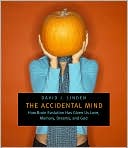The Accidental Mind: How Brain Evolution Has Given Us Love, Memory, Dreams, and God
Search in google:
You've probably seen it before: a human brain dramatically lit from the side, the camera circling it like a helicopter shot of Stonehenge, and a modulated baritone voice exalting the brain's elegant design in reverent tones. To which this book says: Pure nonsense. In a work at once deeply learned and wonderfully accessible, the neuroscientist David Linden counters the widespread assumption that the brain is a paragon of design--and in its place gives us a compelling explanation of how the brain's serendipitous evolution has resulted in nothing short of our humanity. A guide to the strange and often illogical world of neural function, The Accidental Mind shows how the brain is not an optimized, general-purpose problem-solving machine, but rather a weird agglomeration of ad-hoc solutions that have been piled on through millions of years of evolutionary history. Moreover, Linden tells us how the constraints of evolved brain design have ultimately led to almost every transcendent human foible: our long childhoods, our extensive memory capacity, our search for love and long-term relationships, our need to create compelling narrative, and, ultimately, the universal cultural impulse to create both religious and scientific explanations. With forays into evolutionary biology, this analysis of mental function answers some of our most common questions about how we've come to be who we are. Publishers Weekly The brain, that "cobbled together mess," is the subject of this lively mix of solid science and fascinating case histories. Linden, a neuroscientist from the Johns Hopkins School of Medicine, offers "the Reader's Digestversion" of how the brain functions, followed quickly by the "real biology," before tackling the big questions: Why are people religious? How do we form memories? What makes sleep so vital to mental health? Which is more important, nature or nurture? Linden tackles these problems head-on, along the way debunking myths (people do, in fact, use more than 10 percent of their brains) and offering interesting trivia (Einstein's brain was a bit on the small side). Antievolutionary arguments are answered in a chapter titled "The Unintelligent Design of the Brain," in which Linden proposes that it's the brain's "weird agglomeration of ad hoc solutions" that makes humans unique. The book's greatest strength is Linden's knack for demystifying biology and neuroscience with vivid similes (he calls the brain, weighing 2 percent of total body weight and using 20 percent of its energy, the "Hummer H2 of the body"). Though packed with textbook-ready data, the book grips readers like a masterful teacher; those with little science experience may be surprised to find themselves interested in-and even chuckling over-the migration of neurons along radial glia, and anxious to find out what happens next. (Mar.)Copyright 2007 Reed Business Information
Prologue: Brain, Explained 1The Inelegant Design of the Brain 5Building a Brain with Yesterday's Parts 28Some Assembly Required 50Sensation and Emotion 82Learning, Memory, and Human Individuality 107Love and Sex 145Sleeping and Dreaming 184The Religious Impulse 221The Unintelligent Design of the Brain 235Epilogue: That Middle Thing 247Further Reading and Resources 257Acknowledgments 264Index 267








